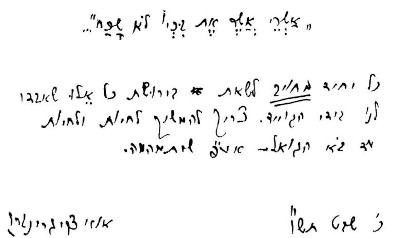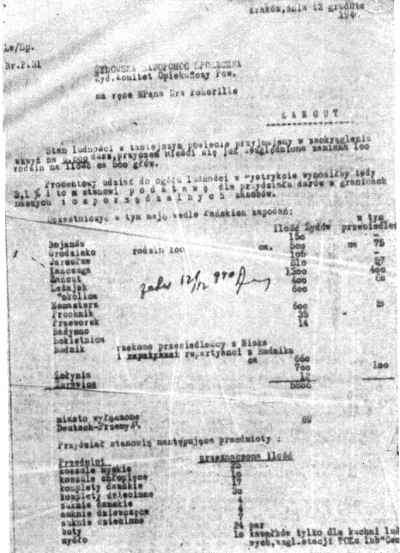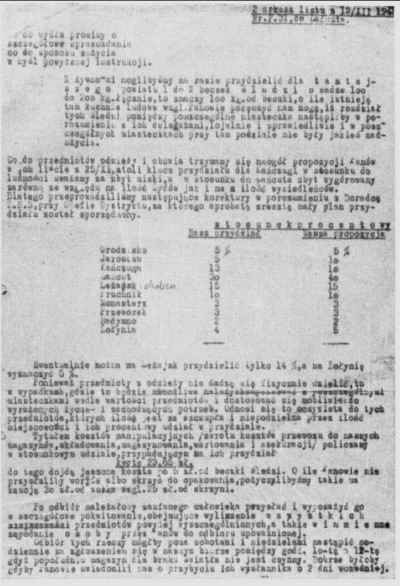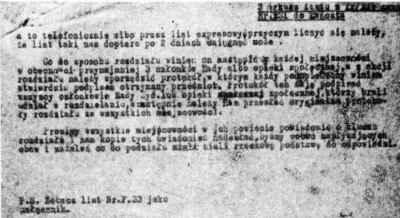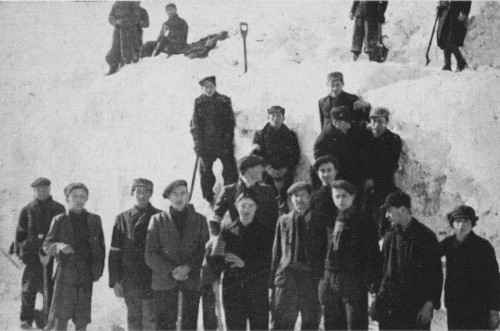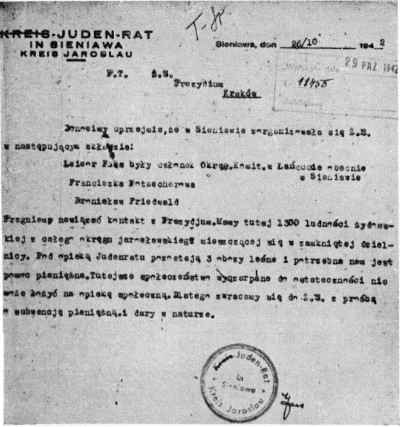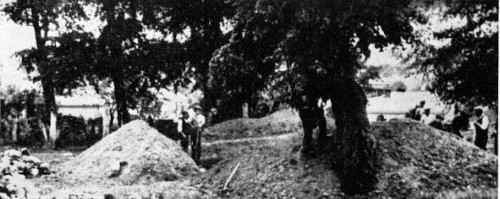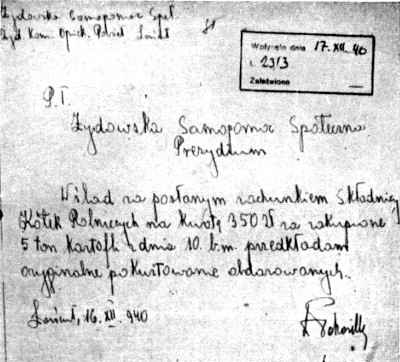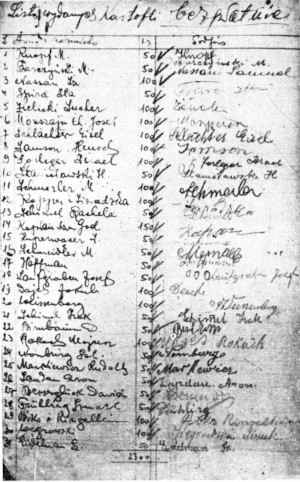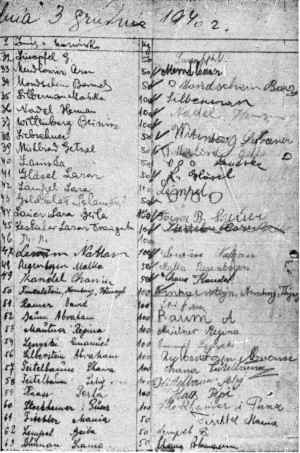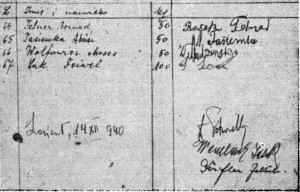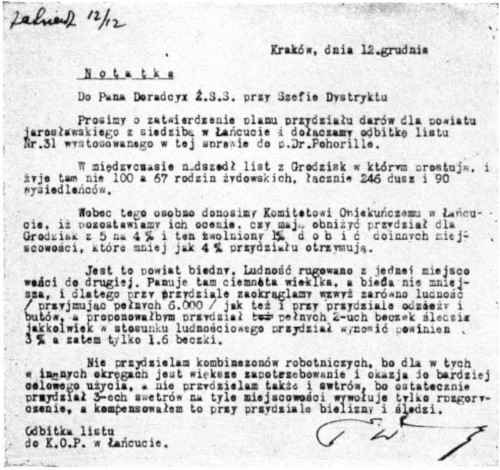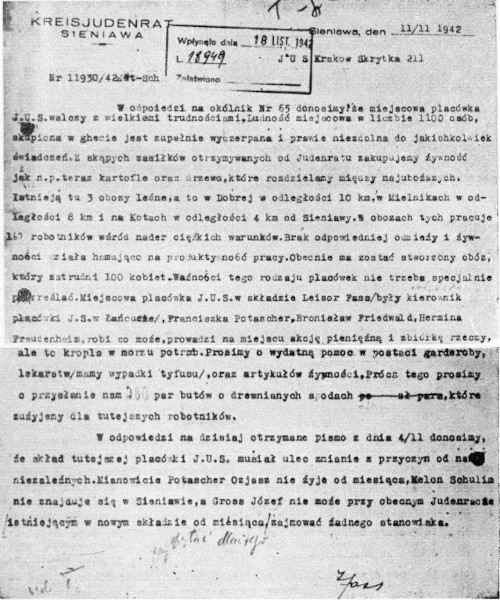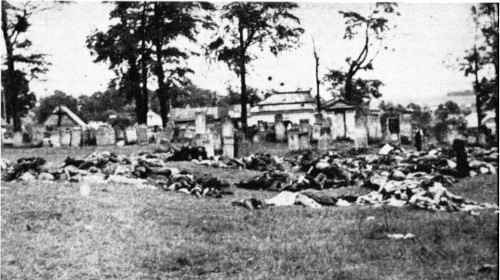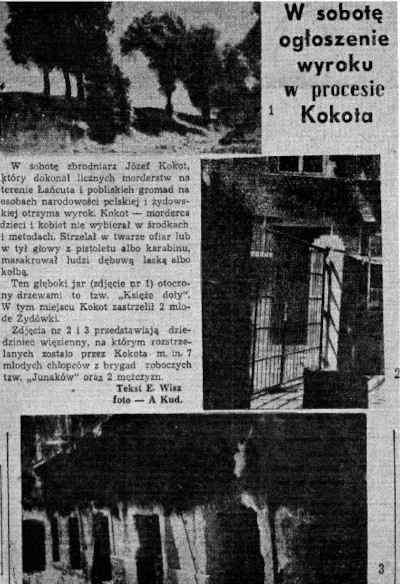[Pages 184-185]
VII
The Destruction
|
|
From a letter to Michael Walzer
“A praiseworthy is the person who has not forgotten his weeping”.
It is every individual's obligation to be the inheritor of those that perished
For us among the gentiles, we suppose to continue to live and live
Until the arrival of the redeemer, even though he is tardy.
Uri Tzvi Greenberg
The twentieth day of Shvat, 5706. |
A tear for my shtetl
by Menachem Stempel, Kfar Johan
I was hurt by love and will go to the desert
I will roar like a lion with a dishevelled mane
I will cry at daytime, and will cry at night
I will collect the tears into my palm.
At daytime the tears will be whitened
At night they will be dark
At sunset they will be reddish
I will dry the tears in the sun
I will thread them on a stalk
I will wrap them on mine wander staff
Wrapped in stillness, I will go to the desert.
|
On the 21st day of Menachem Av, 1942, five thousand Jews from Lancut and towns in the vicinity were taken to the slaughter in the forests of Peklinia. The 21st day of Av. was proclaimed for future generations by the Lancut survivors in Israel and in the Diaspora, as a day of mourning in memory of the destruction of the Lancut community.
Who is able to describe the suffering and resignation of the martyrs during their last minutes of their lives? Who can count the tears or the human expression when being burned to death, with children being mutilated in front of their parents?
Yizkor – Remember
Please remember! Jews of Lancut, your sons and grandsons and future generations, the thousands of Jews of your community and vicinities that were murdered for no wrong doing.
Please remember! The day of mourning in memory of the sanctified that were wiped off the face of the earth and the spiritual and material properties which were destroyed, demolished and looted.
Please remember! The common brother-graves in the Pelkinia woods where the ground contains the bodies of men, women, elders and children, the untainted and sanctified who dies by the most brutal means and their ashes are spread in the Polish Diaspora.
Let's remember! The natives of Lancut that fell on the battle fields, fighting the foe of Israel.
Let's remember! The natives of Lancut who risked and sacrificed their lives in the war of independence for the sake of the revival of Israel as their land.
The souls of the martyrs should be bonded in the bond of life.
Yitgadal Veyitkadash
[Pages 186-192]
The years of the Nazi occupation
by T. Brustin-Bernshtein, Warsaw
Before 1939, the Jewish population of Lancut was about 2,753 souls from a total population of 8,700 people, which meant 30% of the general population.
Lancut was occupied by the Nazi armies on September 9th, 1939, and, as they had done in every other place which came under their occupation, they immediately declared that the Jews were excluded from the law. They ordered the Star of David to be painted on all Jewish stores which made it easier for the hooligans to identify Jewish property and to loot it.
The Jewish store owners were forced to hand over merchandise to the soldiers without payment and a harsh decree was made on Jewish forced labour. In the first days of the occupation, the Jews were forced to do public work in the city; to cover up the anti-air force bomb shelters and to keep the streets clean. The Jews worked under the supervision of Nazi soldiers, who brutally beat, abused and denigrated them.
A short time after the occupation began, the ruling administrators arrived which included a police force. They immediately demanded from the Jews to supply them with furniture and bedding to be delivered to the private quarters of the German functionaries. The police often searched Jewish quarters for valuables.
In the first days of the occupation, the Germans set fire to the synagogue in Lancut. The Jews extinguished the fire and soon after, they repaired the damaged part of the synagogue.
On September 22nd, an expulsion decree was issued in which all the Jews were ordered to leave the city by 16hr and heat east in the direction of Jaroslaw. The Jewish population in nearby cities had received a similar order. Moving west in the direction of Rzeszow was impossible because the German police had closed the road leading to the city. The Lancut Jews had no choice, and, pressured by the occupational authorities, they hurriedly began leaving the city. Whoever could afford, hired a horse drawn carriage and loaded it up with their belongings and were on their way. Some went by food on the road leading to Jaroslaw.
The following day, the following announcement was made: On September 23rd, the German police combed the Jewish homes and forcefully expelled every Jewish family from the city. They were loaded onto trucks and were taken to the bridge of the San River where they were ordered to disembark and cross the river. On the railing of the bridge there were signs that read “The road to Eretz Israel” in German. It was not clear, at that time, exactly where the border between the Soviet Union and Germany was. But it was predicted that the San River would become the border. It seemed then that the Nazi wanted to transfer the entire Jewish population in the Jaroslaw district to the Soviet territory. There was ahung that the order might have come for the German security authorities in Berlin and that they had sent the letter to the local police units in occupied Poland. It is worthwhile to point out that in that rush letter that came from Berlin, there were orders not to concentrate Jews near Jaroslaw. The Jews from Lizhensk, Radymno, Przeworsk and Jaroslaw were also expelled at the same that as the Lancut Jews were. Before the war, there were 2,500 Jews in Lizhensk and on a small group remained, which consisted of the older people, invalids and indigent.
At the end of September, only 25 Jews remained in Przeworsk. There were 2000 people living in that city. In Radymno, there were also only a few Jews left. Jaroslaw, which had 4000 people before the war, only the sick, children and old people had remained. After the expulsion of the Jews, the Nazi robbed every Jewish home of their values.
During the Nazi occupation, Lancut was not a district city like it used to be before the war. The Lancut and Przeworsk districts were attached to the Jaroslaw district. A part of the Lancut Jews took advantage of the fact that the city was close to the San River and did not go to Jaroslaw as ordered. Some stopped in the nearby villages and small enclaves and decided to wait and see how the events would develop. After six weeks, a part of the expelled returned to Lancut without opposition from the authorities.
At the end of 1939, tens of Jewish people that had been expelled from parts of Poland after being annexed to the “Reich”, came to Lancut. They came mainly from Lodz, Kalish, Chozhow and Katowice. Some of the old Lancut inhabitants also gradually returned. Their homes were mostly looted. However, the mistreatment did not stop and the police again kept searching their living quarters for valuables. The heads of the respective families were dragged to the central square and ordered to dig trenches against air-raids. The orders were accompanied with beatings, mistreatment and pain. Among the people who were forced to work was the Rabbi's son. He was forced to take off his clothes and jump naked into the trenches that were full of water. The Nazi denigrated the Jews as much as they could and arranged “shows” on how Jewish denigration was done.
A few days after the episode with the Rabbi's son, the Gestapo ordered the establishment of a “Judenrat” in the city and nominated as head of the “Judenrat”, Dr. Markus Pohorilo.
The following people were selected as members of the “Judenrat”: Eliezer Marder, Shlomo Greenbaum, Leizer Fas, Wolf Gutman, Moshe Ziegel, David Rozenblum, Chaim Leib Kornblau, Yitzhak Weinbach and Israel Gersten. Rachel Sapir became the secretary.
The “Judenrat” were required to delivery daily Jewish workers to clean the streets, remove the snow and clean the floors in the military quarters and offices.
At the beginning of 1940, by orders of the authorities, a registration of all Jews was required to do forced labour. Out of the 900 Jews that were, at that time in Lancut, 157 between the ages of 14-60, which meant 17.4% of the entire Jewish population. They were supposed to appear for forced labour. 84 people were registered as crafts people and 73 as manual labourers. Half of the Lancut Jewish inhabitants were Jews having been expelled from the western parts of Poland. 50 people were called daily to perform all kinds of forced labour.
The Nazi occupants cut down to a minimum the economic resources of the Jewish population. They were removed from farming, commerce and manufacturing. 150 Jewish stores were closed. The two factories in Lancut that were working before the war were closed and from the 30 workshops that were active before the war, only 5 were left. The economic situation of the Jewish population kept on getting worse. On 24th January, a decree was announced that all Jewish property had to be registered. If any non-registered property would be found, it would be confiscated.
Many people hid merchandise and valuables, which they later sold secretly. The occupational authorities kept searching for hidden articles in basements and whatever they found, was confiscated.
Among other restrictions imposed on the Jews by the occupant was travelling by train or other transportation means.
The number of Jews in Lancut kept increasing and at the end of 1940, new refugees arrived from Krakow as well as past residents from Lancut. Krakow had become the seat of the general governor over the entire area. The governor gave resident permission to a limited number of Jews. Therefore, at the end of 1940, there were 1300 Jews in Lancut, which became the largest Jewish concentration in the Jaroslaw district.
| Krakow, December 12th, 1941.
The district communal self-help committee handed the local help into the hands of the revered Dr. Pohorilo in Lancut. According to our estimation, the size of the Jewish population in our District is 6,000 souls. 100 families were included in the above number which meant 1100 souls and considered as 3.1% in relation to the entire Jewish population in our District, which serves as the basis for the help on distribution that is in our hands.
According to your information, the following places would receive help.
| Bojanow 300 Jews |
Grodzisko 500 Jews (100 families) |
Jaroslaw 105 Jews |
| Kantczuga 810 Jews |
Lancut 1500 Jews |
Lezhaisk and vicinity 400 Jews |
| Minstrec |
Prochnik 600 Jews |
Przeworsk 35 Jews |
| Radymnmo 14 Jews |
Rukjatnitca |
Rudnik |
| Expelled from Nisko and returnees from Rudnik: 660 Jews |
| Zhulinia 700 Jews |
Zhurawice 12 Jews |
Total: 5886 souls |
| German Przemysl 69 Jews |
And here are the items for distribution:
| Clothing |
Quantity |
| Men's shirts |
25 |
| Boy's shirts |
10 |
| Women's suits |
17 |
| Children's suits |
30 |
| Women's dresses |
4 |
| Baby girl's dresses |
4 |
| Baby boy's dresses |
7 |
| Shoes |
24 pairs |
| Soap* |
*For the use in the folk's kitchen only health facility “TOZ”. In that letter there was a warning that those who would receive soap had to account on how and where the soap was used. It was also pointed out that 100kg barrels of herring would be sent to each city, or twox50kg barrels. The distributors were required to do a fair distribution in the presence of a representative in each city. In this letter there were also suggestions with regard the distribution of food and clothing.
|
In December 1940, there was in the Jaroslaw district, according to the information that was received from the Jewish Mutual Help, about 6000 Jews, 3.1% of the general population.
The District Committee that handled the Jewish communal self-help, founded in 1940, was not in Jaroslaw where the number of Jews was small but in Lancut where the number of Jews was the biggest in the district. Dr. Markus Pohorilo, the head of the “Judenrat” in Lancut was the chairman of the committee. The members of the committee were: Leizer Fas, and Shmelke Westreich from Kanczuga. The financial and other resources that the committee had at their disposal were very minimal.
For a certain period, there was a kitchen functioning for the people that distributed soup to the refugees and to the local poor. From time-to-time, firewood, coal and food products were also distributed.
* * *
After the outbreak of the war between Germany and the Soviet Union on June 22, 1941, hope increased in the hearts of the Jews that the Nazi would soon be defeated, but the depression had increased when Hitler's army was victorious and marched eastward, more and more. The Nazi terror became worse. In the newly occupied areas, there was a widespread wave of pogroms against the Jews. Jews that had escaped in 1939 to the Soviet areas, found themselves again under Nazi rule. Many Jews from Lancut wanted to return to their hometown in order to join their relatives, but returning home was not that simple. They needed a travel permit from the authorities, which the Germans refused to issue. Many people decided to take a chance and return without a permit. They removed the Star of David from their sleeves, which they were required to wear, and masquerading as Poles, went on their way using every means of transportation they could get, even by foot.
That is how a certain number of Jews, past residents of Lancut, returned home. However, in spite of the fact that they had returned home, the worries and hardships did not end. The German rulers in Lancut had announced that all returnees from the other side of the San River, had to register separately and pay a contribution to the authorities. They were facing harsh punishment for not following orders. For example: In November 1941, six Jews that had come back from the other side of the San River, were executed in the courtyard of the local court. The people that were murdered were: Uli Popjol with his wife Joshua Frei, Chanche Lieberman and Moshe Zonenshein. Shimon Walzer and Eliyahu Reich fell at the same time. The sentence was issued by Joseph Kokot, N. Dzibolski, N. Kritzinger and N. Kirshner.
This execution was not the only one amongst the people who had returned to their relatives in Lancut. Several months after the above execution, tens of people who had recently returned were arrested and four people were again executed in the prison yard. It became clear that the chances to hide those who had returned to the city were nil and those who were hiding, had to report about their return.
|
|
| A group of Jewish forced labour during the clearing of snow in the streets |
A few days passed and twenty Jews from those that had returned, received an order to appear in the city hall. When they appeared at the assigned time, they were lined up and the Mayor, Bernard Bunk, lectured them that they should devoutly work for the German people. He promised that nothing bad would happen to them. Afterward, he asked them what they had done in the Soviet Union. He wanted to know if any of them were a commissar, a member of the Communist party or in the Komsomol. Later, they were sent to clean the snow from the streets. From that day on, they and other returnees were sent to different forced labour, but in separate groups.
Suddenly, the Gestapo whose head offices were in Jaroslaw, began showing an interest in the people that had come back from the other side of the San River. Gestapo agents came to Lancut and arrested 24 Jews that were working in the street. They were held in jail for a few months but one night, they were taken to the cemetery and executed. The Gestapo had executed some more people in the cemetery in Lancut. In March, 1942, a few dozen people were shot, among them was Meir Rosmarin and his wife. In this murder, four local policemen were mentioned having taken part in the execution, together with a number of people from the Jaroslaw Gestapo.
The occupational authorities had restricted the movement of the Jewish population. On December 18, 1941, the head of the Jaroslaw District, Eisenlor, issued an order, under the threat of death, forbidding Jews to leave their residence. The head of the district had described residence as the city limit, village, enclave and an inn.
This order went into force on January 1st, 1942. On March 22nd-23rd, 1942, the Jaroslaw Gestapo arrested many people in Lancut and also took hostages. During the next two days, they also arrested dozens of Poles. On the 3rd day, all the members of the “Judenrat” were summoned to the Gestapo. The summons was bad news. Except for Shlomo Greenbaum, Eliezer Marder and Weinbach, the rest of the members decided not to appear but went into hiding instead. Indeed, their suspicion materialized. When Greenbaum and the others appeared at the Gestapo, they were asked to give the names of ten people to be taken as hostages. They refused to give any names and as a result, they were immediately arrested. Another six people were also arrested. They were picked up in the street. A few days later, the arrested Jews were transferred to Jaroslaw where they were held for four months. On the 16th-17th of July, they were executed.
The occupational authorities in Lancut then nominated a new “Judenrat”. As chairman, they nominated Reuven Nael and the following were made members: Moshe Ziegel, Joel Pearlmutter, Motel Kern, Benjamin Zilfan, Shmuel Zak, Leizer Fass, David Rozenblum, Chaim Leib Kornblau, Israel Milrad and Naphtali Rech became the secretary.
At that time, the occupant began the Satanic plan of the annihilation of the Jewish population in the death camps. In March and April of 1942, tens of thousands of Jews from Lublin were sent to die in the annihilation camp of Belzec, and in May, the additional death camp was activated in Sobibor where tens of thousands of Jews from the Lublin district, from Germany, Czechoslovakia and Austria died in the gas chambers. And from the Krakow district, in which the Jaroslaw region was a part of that district including Lancut. At the start of June, 1942, thousands of Jews from Tarnow and Krakow were sent to the Belzec death camp.
At that time, information had reached Lancut that there was a chance of surviving expulsion by working in a German enterprise. The Lancut Jews feverishly began looking for such places in German enterprises or institutions. Slave labour was still preferred rather than being uprooted to other places.
No one knew then that the term:” expulsion” meant death. They thought tat it had simply meant slave labour in other places. Wanting to remain at home, many looked for work places in German companies that existed in the area.
In July, 1942, the German tax offices began collecting taxes from the Jews which they imposed indiscriminately on everyone without consideration that these people were deprived of any income resources. Their entire basis of existence was selling the belongings that were left to them. For not paying the taxes, everything they had in the house was confiscated.
On July 15th, the head of the Gestapo in Jaroslaw, Schmidt, came to Lancut. Before his arrival, the Jews were ordered to gather in the sport stadium of the gymnasium, to have their personal identification cards, called “Kenkarte” stamped with a special stamp. Schmidt, surrounded by the Lancut police, stamped these documents. The privilege of receiving such a stamp was entirely at his will. Any face which Schmidt did not like, he did not stamp. There was almost someone in every family that did not get the stamp.
Despair overtook the Jewish people because of the unknown future. They searched for way on how to get such stamps. They paid the “Judenrat” for them to settle the problem. The chairman, Nadel, had indeed promised to take care of it but it soon became clear that the stamp was no protection against being “expelled”.
On August 1, 1942, 21st day of the month “Menachem Av”, the date was set for the complete expulsion of all Lancut Jews. The Jews were still thinking that they were being sent to work to the east. When the deadline for the expulsion was announced, the Jews were told that everyone would be allowed to take personal belongings as much as they could carry. Everyone was trying to sell their extra belongings to get some money for them. Panicking, the people were selling their belongings to farmers in the area for the lowest prices. There was a lot of commotion in the city. Farmers were browsing around in the city buying everything.
A few people, wanting to avoid the expulsion, escaped to other places. Some were looking for hiding places in the woods or at some Polish friend. Unfortunately, not many succeeded to escape. There were incidents when Jews were caught on the road before having reached a secure place. In such incidents, the procedure was short. They were shot on the spot.
On August 3rd, 1942, the Jewish population was loaded on horse drawn carts that had been mobilized from the farmers. Guarded by the police, they were expelled to the Pelkinia village, a distance of 14km from Lancut. On the way, the police escorts robbed the Jews and for a promise to allow them to escape, extorted all kinds of valuables. There was a camp in Pelkinia since 1941, established after the outbreak of war between Germany and the Soviet Union. The Nazi kept prisoners of war in that camp. In August, 1942, a transit camp was established for the Jews from the Jaroslaw district.
The camp occupied 70 acres of land, in which 5000 Jews were brought to that camp from the Jaroslaw district. From Jaroslaw, Kanczuga, Prochnik, Przeworsk, Radymno, Zholinia and Gordzisko Dolna. From all the above places, the Jews had been expelled. In Kanczuga, four families were allowed to remain and also in Prochnik a few families were left but they were later transferred to Zieniawa. The imprisoned Jews in Pelinia went through a selection. Elders, sick and children were shot in the camp or in the nearby forest Nichcioli, 5km from camp.
The children were killed in the woods by hitting their heads with wooden sticks and thrown into a pit of lime. Many people that the bullets had not killed were buried alive. A part of the women were sent from the Pelkinia to the death camp of Belzec. The young and strong were sent to different slave labour camps.
After a short say in the Pelkinia camp, the Nazi sent a group of 50 people to Lancut. The members of the “Judenrat” were also returned to Lancut. The return of the Jews to Lancut made it somewhat easier for those who were in hiding and had refused to obey the expulsion order. They could now leave their hiding places without being noticed and mix in with those that had returned legally from Pelkinia and find work in order to get a working document which made them eligible to get back their previous residence. The people who were hiding in basements and attics were able to get food from the Jews who had come back legally to Lancut. The people who got back their residential places would also help arrange hiding places for their relatives and friends in their living quarters and take care of them after coming home from work.
There were incidents when the Polish underworld discovered Jewish hiding places and reported them to the authorities. The Jews were shot in the cemetery or in the local prison. Some were shot in the street. In August, 1942, five Jews were shot near Kraszewski Street and near number 29, Listopada Street. They were: Sarah and Frimet Worm, Kalman Wolkenfeld, his wife and their child. In September, 1942, nine Jews were shot in Sobieski Square, among them were: Simcha Sapir and Israel Wanger. During the same month, eight Jews were shot on Walowa and Slowackiego Streets. Among them were: Golda Goldman, Mendel Rif or Rip, L. Kornblau and Markus Weinberg. The wife of the “Judenrat” member, Shlomo Greenbaum and the couple Trumpeter, who were discovered in their hiding place, were shot in the same period. A Polish woman with the name Nizhilowa, was shot for giving shelter to Jews.
In September 1942, only fifty Jews were left in Lancut. Gestapo people were arriving daily from Jaroslaw, and hearsay spread in the city that the Lancut Jews would be transferred to a ghetto in Sieniawa which was being established at that time. Indeed, on September 17, they were all sent to Sieniawa which was on the other side of the San River. At that time, Sieniawa was the only place in the Jaroslaw district where there was a large concentration of Jews. Some Lancut Jews were in several labour camps near Sieniawa. The members of the Lancut “Judenrat”and members of the Jewish self-help committee, including Mr. Leizer Fas who later became the chairman of the Jewish self-help as well as chairman of the Sieniawa “Judenrat”, were all in Sieniawa. More about them in the next chapter.
In the meantime, here is the story about the Jewish concentration camp in Sieniawa, where in May, 1943, the last of the Lancut Jews perished. Those who, somehow, managed to escape from the paws of death in the Pelkinia transit camp, or from being sent to the death camp in Belzec, Sieniawa was annexed to the Jaroslaw district when the Nazi armies occupied the territories on the other side of the San River, after the outbreak of the war between Germany and the Soviet Union.
From a letter from one of the Sieniawa “Judenrat” member by the name Osias Futcher, dated June 2nd, 1942 (from a document “Yus” 358 in the archives of the Jewish Historical Institute in Warsaw), we found out that there had been in that city about 1800 Jews whose majority lived in an unimaginable wretched life of starvation.
The Jewish District Council
Sieniawa, Jaroslaw District, to the revered (P.T.)
Zydowska Samopomoc)
The Presidency-Krakow.
We would like to inform you that a Jewish self-help has been organized of the following composition: Leizer Fas, who was the chairman of the Lancut District Committee, now in Sieniawa, Franciszka Futczerowa, Bronislaw Fridwald.
We would like to come in contact with the presidency. We are here a Jewish population of one thousand and three hundred people that were concentrated from the entire Jaroslaw district and reside in a stacked-up quarters.
The Jewish Council supervises three labour camps in the forest and we are in dire need of financial help. The community doesn't have any means of sustenance and we are not able to extend any help to the needy. Therefore, we are appealing to the self-help Committee and pleading for financial or similar to a financial grant.
(Stamp)
The Jewish Council in Sieniawa.
Jaroslaw District. |
The local chairman of the “Judenrat”, Ely Gross, was, at that time, nominated as the Jaroslaw regional chairman of the “Judenraten”. The meaning of such nomination meant that the occupational rulers were preparing for the final annihilation of the Jews and these suppositions were connected with the personality of Gross. Ely Gross did not last too long in the post as the regional chairman of fifteen “Judenraten”. In the meantime, many Jewish concentration places in the Jaroslaw region were being liquidated.
On July 19th, 1942, which was one day before the biggest liquidation “action” took place. A self-help representation was founded in Sieniawa where the above-mentioned member of the “Judenraten”, Osias Futcher, became the chairman and his colleagues, Shalom Melon and Joseph Gross (apparently a relative of the regional “Judenrat” Ely Gross), were the members of the committee. In a letter dated August 26th, 1942, the self-help representatives informed the presidency of the Jewish self-help organization in Krakow that Sieniawa would become a Jewish concentration for the entire Jaroslaw region, but at present, no number is known. Osias Futcher in his letter from September 11th, 1942, to the presidency of the Jewish self-help in Krakow had informed them that by order of the Nazi authorities, a labour camp was established ten kilometres from Sieniawa. The labour camp located near a forest had 200 people including thirty young girls. These people were from Lancut, Kanczuga, Zholinia and Lizhensk as well as a few other places in the Jaroslaw region. They came to the camp without clothing, underwear or shoes. In the same area, there would be two more labour camps established where the inmates would be working in the forest. One of those camps was Bakti, about four kilometres from Sieniawa and the second camp was Milniki, about eight kilometres from Sieniawa.
Osias Futcher was murdered in October, 1942, apparently together with other colleagues from the “Judenrat”. At the end of October, a new representation was organized with a new composition. Leyzer Fas became the chairman and the members were: Osias Futcher's wife, Franciszka Futcher and Bronislaw Fridwald. Because of the continuous murder of Jews by the Nazi, the number of Jews kept decreasing in Sieniawa. At the beginning of June, 1942, there were still 1800 Jews in Sieniawa. At the end of October, there were 1300 Jews, and in the first part of November, the number of Jews had decreased to 1100 Jews only.
In May, 1943, the majority of the Jews in the ghetto in Sieniawa were killed in the local cemetery. A smaller group was sent to concentration camps.
In the spring of 1944, when the Germans suffered defeats on the fronts and the Red Army were closer to the Polish border, the murderers had organized special units to cover up their evil doings. At that time, Jewish bodies that were murdered in May, 1943, in the Sieniawa cemetery were also removed.
From the Lancut Jews, only a small group survived the Nazi occupation period.
The Nazi were feverishly searching for Jews in hiding, which upon discovery, were immediately shot on the spot by Nazi police. From December 1942 to March 1943, continuous executions took place. In December 1942 and January 1943, Jews from Lancut and nearby villages were executed in the Lancut cemetery and among them was Leyzer Bezemshtok from Lancut.
In March 1943, the wife of Markus Pohoril was discovered in hiding and murdered. A woman with a child was also discovered hiding and were also shot.
The small group that had survived the Holocaust succeeded only with the help of having Aryan documents. They left for other cities where no one would recognize them and, therefore, hoped not to be recognized as Jews. A few went to Warsaw where they survived, and they were: Diana Greenbaum and Dr. Adam Meir.
Bibliography
- Archives of Jewish Historical Institute in Warsaw. Documents: “Yus” 221 Lancut, 358 Sieniawa, 146, Kanczuga, 553.
Statistic material, 134 Jaroslaw and 301 Prochnik.
- Archives of the historical institute documents A.I.D.C. N°72. Jaroslaw 1414 statistic material.
- Questionnaires of the National Memorial Institute.
- Archives of the main committee to investigate Hitlerites' crimes n°984/72 9843.
- Historical Institute Archives. Witnesses' testimonies: 840 Regina Landau and 150 Diana Greenbaum, 4922 Yaacov Kestecher, 2156 Shlomo Katz, 3304 Alexander Lubash and 1783 Peter Kochura.
[Page 193]
To my brethren in distress…
by Pesach Gotlieb, Givatayim
I will bring up unforgettable memories from the past which should remain as a document for generations. You surely remember the day when the Nazi ordered the Jews of Lancut to gather in the courtyard of regional office. I did not know why, but when I heard the announcement, I was sure that it was probably about work and because they were looking for free labour, they would force the Jews to work. Well, I went. To describe the picture of the “welcome” we received while entering the “torture yard” with all the details, only a professional writer could do it. After all, twenty years have passed, but such pictures cannot be forgotten.
When we arrived at the entrance of the courtyard, two rows of soldier savages were waiting for us on both sides of the narrow passage with sticks in their hands. They were lined up at a length of some twenty meters and the passage was full of obstacles to make it harder to run through speedily. Imagine the beatings we received just by entering the courtyard. When we arrived inside the courtyard, we discovered a scene that can only be seen in a movie about wild people in jungles, even worse. The savages collected the men, lined them up in rows and began physical training by the accompaniment of brutal beatings with these sticks indiscriminately, young, old or invalids, etc. If I would not have experienced this myself, I would not have ever believed that “cultural” people were capable of doing such things. Of course, at present, after each of us knows already the horrors that were inflicted upon our nation in those crazy days, the impressions have faded just a little bit. But for the people that experienced for the first time, they will never forget.
A small example: You probably remember the bathhouse keeper. He was limping and he was ordered to run, but he couldn't. You have no idea how many blows he sustained. It was only a miracle that he did not die right there. Of, for instance, Elimelech Shteiner. His head was injured during a bombardment and his head was bandaged. They tore off his bandages and hit him with horrible brutality which cannot be described in words. These people withstood the torture but they did not lose their image of God. They were the real sons of the “hard-neck” People.
On this occasion, let me tell you what I went through during this “execution”.
After they lined us up in rows, we were ordered to empty our pockets, put the contents on the group, step forward three steps and they, the savages behind our backs, checked the contents (if there was anything to rob). Then, we returned to our places. Incidentally, there was an autumn thin drizzly rain that day, “befitting the occasion”. The things that we had put on the ground became wet. I had a gilded pocket watch which apparently got stuck in the ground. When we retreated the three steps and everyone remained standing near his contents, an officer and a soldier came over (we were surrounded and guarded by soldiers). The soldier showed the officer the watch and said that I had tried to hide it in the ground. The officer ordered the soldier to put against the wall. He put against a bush and the soldier was ordered to him me. How many ‘hours’ did I stand there and wait? I cannot say. Maybe it was only a few minutes but what went through in my heart and mind at that time, I cannot put on paper. A man stood and waited for a bullet that would pierce his heart and put an end to his life. Without having committed any crime. Every minute seemed like a whole year. Nonetheless, I thought to myself – what was a man supposed to feel and think in such a moment? I recalled the Russian writer, Andreev, who described in his book about seven people that were hanged and how people sentenced to die accept their sentence, each with his own emotion, probably. What I thought was that I am one of them and I will try to describe it with words. As much as I can remember, an inner struggle was going on inside me, between my heart and the perception of death. I knew that my death sentence was a fact and the murderers would do it and I was resigned to die. I was overtaken by a helpless emotion, but my heart refused to accept the sentence. I was expecting a miracle. Perhaps a miracle would occur after all? Indeed, a miracle had occurred. I was lucky that when I stood in my place, another officer came by who was not present during the incident with the watch and he asked me: “Why are you standing here and not in line with the rest of them?” I, innocently responded that I did not know but that maybe other people would come and join me in order to make another row. It seemed to me that the Germans were in a hurry to reach Przeworsk and do the same thing over there as they had done in Lancut. He “measured” me from top to bottom and will all his force, hit my head several times with his stick until the stick fell apart. He ordered me to return into the row. You can imagine that I did not wait a minute to return and mix in with the crow.
From a distance, I noticed how the first officer was looking for me and this was the miracle that had occurred. After I returned to the crow, they did with us some more “exercises”. Later, they pulled out some people from the lines according to a list in their hands that had been prepared in advance – the “wealthy” of course. Incidentally, I only remember that they called Moritz Feilshus. The rest I don't remember. There were about fifty people which were called out and were loaded onto a truck. Where they were taken and what happened to them, I do not know to this day.
The people that remained in the yard were ordered, first in German and then in Polish, that all Jews indiscriminately of age, had to leave the city by 16hr and they could take with them 100 zlotys and go east until they reached the San River. Anybody that would remain overnight would be shot. Anybody trying to go west would also be shot. If more than 100 zlotys or jewellery would be found on a person's body, they would be shot.
After listening to the “Ten Commandments” they did not wait for us to say “we will do and listen”. The Germans seemed to be sure that we would obey their orders. Next, they ordered us to come closer to each other until we became one big human mass. They ordered us to go down on our knees, they opened the gates and then commanded us to crawl out on our knees while they were hitting us with their stick, telling us to run outside and get ready for the tour.
You know what came next because you were one of us. We wandered until we arrived, luckily, and met our new comrades (Towarish). After this experience, I felt, for a long time, as though someone had penetrated my breast and squeezed my heart that left me breathless.
This letter I am writing nineteen years later when we merited the beginning of the redemption, and I hope that we will soon be redeemed.
[Page 194]
My escape to Russia
(from a letter)
by Moshe Rozenblit, God should avenge his innocent blood
More than eight months have passed from the day that I left Lancut my town. I still remember the day when we left, my mother, my family and I, to an unknown path. We walked under a rain of bombs and machine gun fire. We walked in a sea of tears and blood. We walked without knowing whether we would ever reach a safe haven. Men, women and children kept falling around us. Oh! Those kids! Can anyone imagine a more horrible scene of helpless children – children that did not understand what was happening? And they were being killed by bullets aimed on them by the hands of the Nazi murderers who kept on flying low in their planes over the human masses that were on the move on the roads. God of revenge, where were you? I would never have imagined myself to be so full of desire for revenge. But if a German soldier had fallen into my hands, I would have killed him with my bare hands.
We walked by foot, five hundred kilometres and reached the Soviet Union. As of now, I am a different person. A person that believes in everything. Everything is possible, everything can happen, after seeing the bloody road from our city until here.
Russia, do you remember how we used to talk about this country over there? With what curiosity we spoke about her? How we yearned to see some day this wonderland and find out about the ruling regime? And yet, I am here in the midst of this life, even though I am wounded and cloven.
This is a huge country. Everything here looks different. The people, the land, the air which we breathe. The people seemed to be hardened, their faces bronzed or rather waxen. The foreheads sticking out. There is a certain openness in the average people. Not too often you encounter a person laughing. I try to get acquainted with that sort of life, learn their language that stands out with its soft and gentleness. The language of Dostoevsky and Tolstoy.
Perhaps – for a second it is, as if my eyes are fogged and enjoy dreaming that I will put in new roots here and I will acclimatize. I will build here my home, a pure, small home and become equal with the folks and my comrades will come to visit me in my home. Ha! How do you like this idea?
From a certain point of view, you can say that this land fills up the human hearts with hope on the one hand, and on the other, it is filled with fear. Hope, because of the many opportunities it possesses and fears, and it is the fear for the future, for the next day.
People here are not bad. They only keep “reminding” you that you have to work, work and work. They work on command, following an order, by request, without being connected with human interest and personal choice. You are like an apparatus which is ordered to move in a certain direction. It is a multicoloured new world.
Outside, the storm is wailing, hellish fire, World War is running wild with brutality that was never heard of. In my hope are the Germans. You know what the German Nazi are? Six hundred and ten Jews were shot in the first days of the war in Przemysl, seventy in Dynow, thirty-seven in Sendziszow. If I could only describe the supplicating eyes of the Jews that were killed over there, merely just for the brutal pleasure of the murderers. The heart is filled with supplication, screaming for revenge that should happen in order to repay for the sea of tears and blood.
Dr. Just is in Bolechow. Itzik Popiol and Itzik Greenbaum are in Lemberg (Lwow). Ninety% of the Lancut men are here. Josek Tuchfeld is in the Crimea. Many others are in Donbass. Josel Seifert died in Lemberg. Regards for everyone native of Lancut that you will meet.
To all Lancut natives, have peace wherever you are. Will we have peace?
Time will tell.
[Pages 194-195]
The job story of Leizer Fas[1]
by Michael Walzer
During the thirties, Leizer Fas was known in Lancut as a Zionist activist. He was different from many young people of his generation. Perhaps because of his childhood, which was during very hard times. He was born in 1899 and when World War I broke out, he lost his father in at a young age and became responsible for the welfare of his family. His father, Nachman Walzer, was mobilized into the army and the fifteen-year-old boy had actually become the father of the family.
During the years between World War I and II, he was an activist in the Zionist movement in Lancut. A big role was destined for him in the Beit Haam activity in the city. In his letters from that period, he heralded with great joy that Count Potocki had donated seven thousand roof tiles for the Beit Haam roof. In other letters, he expressed his worries about the burden of the debt that the Beit Haam had sunk and about election discussions and struggles. He was a man with a character which impacted many of the young people in that period. A devoted and dynamic character. The Beit Haam in Lancut continuously kept him busy. Every address he came across in every part of the world, he would write and ask for help. He lived with the institution's problems where he was the secretary.
The same thing happened during the election campaign to the Polish Seym (Parliament) and the Senate. Most of the general candidates' list and all the Jewish candidates' lists were cancelled. The Polish leaders in Lancut came to the synagogue during the reading of the Torah and made speeches demanding to vote for the government candidates. Many Jews supported the idea, relying on the quotation in the Talmud: “Dina Demalchuta Dina” (Jews ought to obey the rule of the country). There was a certain satisfaction that they were interested in the Jewish votes. But the young people audaciously rebelled against the Polish leaders of the community and Leizer was among those that yelled to the speakers: “Go and speak in the church! Why did you come here?” These rebellious young people campaigned for the Zionist candidate's list to the Senate, being constantly under the watchful eyes of the local police which forced them to often change the election campaign quarters. One more characteristic of Leizer Fas' personality in those days was that he loved to act in plays and drama. He participated in many theatrical performances and always had a leading role.
That is how Leizer Fas spent his youthful years and how the “unescapable boring years in the Diaspora” passed by, which was how he had described them. In 1933, he married Ryvka Bot and moved to Czarny Dunajec. He made his fortune there having a flour mill and a fodder business. The businesses were profitable and they lived a comfortable life. They did not have children until 1940. However, amidst war, suffering and pain, their only child, a girl was born. His wife and daughter and himself had drunk the cup of sorrow together with the Lancut Jews. He managed to remain almost the last Lancut Jew but fell after facing horrible tribulations.
The chapter of his suffering reminds us of Job from the Bible. He took advantage of his influential power and talent to act and help. But his life was cut short with astounding brutality during the Holocaust.
The first year of the Holocaust
The Lancut Jews were expelled from the city in 1939 as soon as Poland was conquered. Many escaped to Russia, many dispersed, and a small group was left in Lancut. Among them was Leizer Fas with his family, his mother and sister. At that time, many of the “Folks-Deutsche” (Polish born Germans) exploited the situation and pestered the wealthy Jews to disown them from their wealth or murder them and late take over their property as their own. That is what happened to Leibish and Yaacov Bot who owned a flour and lumber mills. One morning, it became known that they had both disappeared. It became known that a “Folks-Deutsche” by the name of Dlung, had conspired to their killing. Leizer, using his influential contacts, went out in the fields searching for their bodies and brought them to “Keiver Israel” (ritual Jewish burial). He was successful in his task. The Bot brothers were the first victims in Lancut that were buried with a burial reserved for Jews who sanctified their life for the Holy name.
One tragedy after another
During the occupation, Leizer had a bakery and from time-to-time, in order to save a Jewish young man's life, he employed them. He employed Shimon Walzer, my nephew, but a short time later, Shimon was found killed in his working place. Leizer Fas had constantly fought the waves of death that surrounded him.
Shimon Walzer's sister, Chaya, had hardship to be consoled after her brother's death. She wore black and refused the insisting friends not to demonstrate her special mourning because the mourning belonged to everyone. Chaya attempted to run away from the city. She boarded a train filled with Poles. She was recognized being Jewish and the Poles threw her out from the speeding train into the snow. She was instantly killed. Leizer, the activist had again the task of finding her body to give her a Jewish burial.
He was a member of the local “Judenrat” where Dr. Pohorilo served as chairman. It was a delicate and hard job. At times when he was supposed to come to a meeting, he was informed by who knew, not to appear because his life was in danger. He used his job always to be at the place where the tragedies of his family members had occurred, when they were murdered, one after the other. That is what happened when the family of his niece in Rzeszow were murdered by the Germans and their bodies were thrown into a lime pit. His “merit” stood by him and he managed to retrieve the bodies and bury them.
His first daughter was born, as mentioned before, in February 1940. T one occasion, they tried to separate the mother from the child during her attempt to hide her. She refused to be separated. “We will both share our fate”, she declared. Indeed, destiny materialized her wishes. They were both killed in 1943.
Nachman Walzer was caught by the Germans during his attempt to smuggle milk from the Przedmiescie village for Leizer's daughter. They locked him up together with 45 other people who were arrested for different “crimes”. When the Lancut people were expelled to Pelkin with the purpose to be annihilated, the 45 arrested people were killed, including Nachman Walzer.
The same year, part of the “Judenrat” members were exiled to Jaroslaw where they were killed after having been tortured. Leizer was among the few that survived. In August, Leizer's mother and my mother, Malka Walzer, were exiled to Pelkin with the rest of the people from Lancut for the purpose of annihilation. However, 50 people returned to Lancut and among them was Leizer.
In the winter of 1943, the last surviving Jews were locked up in the Sieniawa ghetto and Leizer and his family were among them. And since then, his trace disappeared. This was the year when he perished.
* * *
He was a tragic figure of a man with a high spiritual level – a one of a kind. A talented man who gave his best years to spiritual things: art, culture. He was a man who fought for the rights of the Jews. He was uncompromising and showed no favouritism. His success in business was also thanks to his talent. Destiny had prepared for him not just ‘to live a boring life in the Diaspora’, to quote his expression, but to witness the tragic end and the destruction of the people of his city, the murder of his family, the denigration of everything that was very dear to him and in the end, he fell like a hero in the drama. He finished his bitter life, satiated with suffering and sadness.
This was Leizer Fas. He is standing before my eyes as though he was alive with his bright look; a little hardened face, saying: “I went through this world and I am ready for whatever comes in because this world is brutal and the Diaspora is brutal”.
Translator's footnote:
- Leizer Fas was married to Ryvka Bot, the translator's cousin. Return
[Pages 196-201]
Appendixes from the Holocaust period
by Michael Walzer
| Lancut, September 26, 19..
From the Lancut Jewish Community.
To the Jewish Self-help Committee in Krakow.
In response to your circular N°1-2, we are enclosing the list of institution which existed in our city before the war. Near the names of every institution, we attached the details about their activities. We also made a note, if the institution existed on its own with an independent basis, or was a part of another institution.
As of today, none of these institutions exist. As for the immovable property that was registered to the Jewish institution of “The Beit Haam” and the cultural institution, according to their by-law, the immovable property which they owned was passed to the Elective Jewish Community. This property with the other immovable property of the Elective Jewish Community, has been registered as property of the Jewish Community. Where the other institutions were concerned, they did not possess any immovable property.
Chairman
Signature: Dr. Pohorilo.
Secretary.
Signature: Naphtali Reich.
Stamp
The Elective Jewish Community
(in German).
Archives of the Historical Jewish Institute, Warsaw.
Documents: “Yus” N°221.
- The society “Beit Haam” exists since 1926. From 1930, they own a building with an auditorium for plays on Druker Street, 1. 557 K.L.O. The activities are cultural and educational. Since the outbreak of the war, the Association is not active anymore and in accordance with its by-law, the ownership of the building (during the dissolution) was passed over to the Elective Jewish Community. The Association of the “Jewish Beit Haam” existed on a legal basis.
- The “Tarbut” School Association and preparatory Hebrew school had an independent legal status and held three rooms in the “Jewish Beit Haam”. There were libraries that were called “Daat” and “Ahavat Zion”, which possessed eight thousand books in three languages: Polish, Hebrew and Yiddish. Part of these books were stolen, however, about five thousand Polish books, the city council of Lancut had transferred them to the Boromauszek Monastery in Lancut. Since the outbreak of the war, according to the by-laws, the three rooms together with the “Beit Haam” in its entirety, had passed to the ownership of the Elective Jewish Community.
- The Jewish folk's library, as a legal entity, did not possess any immovable property except the library which was in possession of three thousand books, stored in the Elective Jewish Community.
- The “Jewish Women Association” in its approved independent legal status and whose purpose was to help financially and morally the sick and the poor. They were also distributing daily, breakfast for poor children in schools. Since the outbreak of the war, they no longer exist and no immovable property was left.
- The Jewish Women Association “Wizo” had an independent legal status and had no immovable property. Since the outbreak of the war, they ceased to exist.
- The “Mizrachi” Association had an independent legal status but did not have immovable property and since the outbreak of the war, they ceased to exist.
- The Jewish sport club, “Trumpeldor” was an independent legal entity which had its place in the “Beit Haam”. In addition to the sport section, there was also a musical department called “Hazamit”, a string and brass orchestra with a note library. The instruments were confiscated by the military and since the outbreak of the war, this organization no longer exists and no immovable property was left.
- The Associations, “Tomchei Aniyim” and “Nosei Mitah” had the purpose of helping the poor and sick and giving last kindness to the deceased. They also gave interest free loans using public funds and membership fees. They were also active in giving spiritual support. Since the outbreak of the war and the eviction of the Lancut Jewry in 1939, the Association ceased to exist. The funds were distributed among the members and no immovable property was left except for a “Mishnayot” library.
- The assistance “Gmilat Chasadim” Association, which was giving interest free loans using funds that they had received from abroad and from the American Joint Distribution.
Signed by: Dr. Pohorilo
Chairman.
Signed by: Naphtali Reich
Secretary.
The stamp of the Elective Jewish Community (German)
A handwritten addendum in Polish.
The stamp was not clear.
“Jus” document N°221.
Announcement
1. Further on, I am hereby informing the public, the text of the third order verbatim in connection with the restriction about staying in the General Gubernatorial territory, issued October fifteen, 1941 (official newspaper 66, N°99, page 595) as follows:
Based upon paragraph five, indication one, from the Fuhrer's order issued October 12, 1939 (official newspaper of the German Reich N°2077) I am therefore ordering:
Section 1
In the order in connection about staying in General Gubernatorial territory from April 29, 1941 (official General Gubernatorial newspaper, page 274, should be added, after paragraph 4A, the following:
- Jews leaving the residence assigned to them without permit will be facing the penalty of death. The same penalty will be applied to those who give hiding places to Jews.
- Instigators and helpers are facing the same penalty, as though they had committed the crime of leaving the ghetto. Planning to leave will be considered as the crime was committed, in extenuating situations they might face harsh imprisonment.
- Dealing with such cases will take place in special courts.
Section 2
This order will be enforced on the day of its publication.
Warsaw, October 15, 1941.
General Governor,
Frank.
Ordinance
On the basis of paragraph 1, N°1, from the staying restrictions in the General Gubernatorial Territory, order issued the ninth of September, 1940 (official newspaper 1 N°55, page 288), I am ordering within the framework in Jaroslaw region, the following:
- As residential areas according to the restrictions of staying in the General Gubernatorial territory from October 15, 1941, I am designating for the Jews and Jewish women from the Jaroslaw region, their present residence as such. The same goes in other places if no special section of residency for the Jewish population was designated until now.
- As a place of residence, is being considered the city community, the village where the Jews live as on the day that this order went into force.
- As leaving the residence without a permit will be considered those who left the perimeter of the community which was designated as the Jewish quarters.
- This order went into force on January 1, 1942.
Jaroslaw, December 18, 1941.
Chief of the region, signed by:
Dr. Aisenlir.
I am hereby confirming the authenticity of this copy with the original.
Jaroslow, February 3rd, 1947.
Secretary, Z.M.
Signature: Magister, Feltchak. |
|
|
|
The Public Jewish Self Help.
The Self-Help Committee, Lancut reg.
Received December 17th, 1940.
To the revered (P.T.)
The Jewish Public Self-Help, the Presidium.
Following the invoice of the agriculture organizations in the amount of 500 zlotys, for the purchase of five tons of potatoes on the 10th of this month, I hereby enclose the original signatures of the free-of-charge recipients.
Lancut, December 16th, 1940.
(The signature) Dr. Pohorilo. |
|
|
|
List of Jewish Families that received potatoes free-of-charge:
(50 or 100kg).
- Knop M.
- Barczinski M.
- Nasau Miz.
- Spiro Ita
- Zlinski Soter
- Monshein Ch. Joseph
- Shlachter Godel
- Samson Chanoch
- Forleger Israel
- Stanslawski H.
- Shemelcer M.
- Reper Wsirdecka
- Shimon Rachela
- Kaplan
- Kuperwaser
- Shneidler M.
- Hofman
- Laufgarben Joseph
- Daik Yaacov
- Wesenberg
- Shimel Isaak
- Birnbaum D.
- Rokach Mozes
- Nomberg Sz.
- Landau Aaron
- Mokowich Rudolph
- Beserglick David
- Frihling Szmeril
- Biks and Ringelbein
- Engrowski
- Eidelman Sz.
|
|
|
|
- Zisappel
- Mendelewicz Aaron
- Mondshein Baruch
- Zilberman Malka
- Nadel Herman
- Wittenberg Heinisz
- Liberner
- Milrad Getzel
- Lemska
- Glezel Lazar
- Lempel Sarah
- Goldblat Salomon
- Sauer Sarah Beila
- Kezsztecher (?) Lazar
- ?
- Zamen Natan
- Regenbogen Malka
- Kendler Chaim
- Finkelsztein Nomberg
- Remer David
- Baum Abraham
- Mautner Regina
- Lentczycki Emanuel
-
- Zilbersztein Abraham
- Teiltelbaum Chawa
- Teitelbaum Zelig
- Haas Perla
- Sztokhamer Foinc
- Fiszler Mania
- Lempel Beila
|
|
|
|
- Blumen Sziana
- Flecher Bernard
- Sztiemka Abusz
- Wolfowicz Mozes
- Sak Feivel
Dr. Pohorilo.
Weinbach. Yitzhak.
Derfler. Jakow. |
|
|
|
Krakow, December 12, 1940
Announcement
To the Advisor of the Jewish Public Self-Help.
At the Head of the Region!
We are hereby requesting the approval for the help distribution plan, free of charge, for the Jaroslaw region, which is located in Lancut, and we are enclosing a copy of the letter n°31, which was sent on the matter to Dr. Pohorilo.
In the meantime, we have received a letter from Grodzisk, in which they are informing us, not that they have 100 Jewish families, but 67 consisting of 246 people and 90 exiled people.
We, therefore, suggest to the Self-Help committee in Lancut to reduce, at your discretion, the allocation of the products for Grodzisk from 5% to 4% to add to other places which receive less than 4% from the allocation.
The region is very poor. The population was moved. (Expelled. Translator's remark) from place-to-place, great is the darkness and the distress has increased. That is why we rounded up the total number of people for the distribution of food purpose, which is in our estimation, six thousand people, and the same is our opinion on clothing and shoes. I would suggest to allocate two barrels of herrings, in spite of the fact that according to the number of the population that are eligible to three percent and should get 1.6 barrels of herrings.
I am not allocating any working clothes to the local workers because other regions need these clothes for better use. I am also avoiding allocation of sweaters because, giving three sweaters to such a big number of places, will only cause bitterness, but I might try to compensate them with underwear and herring.
A copy was sent to the K.O.P.
Lonhartz. |
The Regional Jewish Council in Sieniawa.
N°11930/42
Received: November 18, 1942.
N°18949 J.U.S.
In response to the circular N°65, we would like to inform you that the local J.U.S. is encountering tremendous hardships. The local population whose numbers has reached to 1100 people, locked up in crowded ghettos, and are week and feeble, unable to do any kind of work. From the poor doles that we have received from the “Judenrat,” we bought potatoes and firewood which were distributed to the very poor.
There are three labour camps in the forest. One is in Dobro, which is about 10 kilometres from here, in Mielnik, 8 kilometres and in Koti, 4 kilometres from Sieniawa. One hundred workers are working in these camps under the heaviest conditions. The shortage in clothing and food decreases productivity. They are planning to establish an additional camp where they will employ 100 women. Needless to point out the importance of these working points.
The local committee of the J.U.S: In composition of Leizer Fas who was the manager of J.U.S. In Lancut, Franciszka Futcher, Bronislaw Fridwald, and Hermaina Freudenheim, are doing everything possible. They collect money and products but it is like a drop in the sea in comparison to the needs. We send our plea to you! Send us clothing and medication (there are cases of typhus), and food. In addition to the above request, please send us 200 pairs of shoes with wooden soles for the workers.
In response to the question in your letter dated February 4th, we hereby want to inform you that in the local composition of the committee J.U.S., a change has occurred for reasons beyond our control. Futcher Osias passed away a month ago, Melon Shulim is not in Sieniawa and Joseph Gross cannot, in the present composition of the committee, take any position.
(A handwritten remark, question why?)
(Handwritten signature of) L. Fas. |
[Pages 202-205]
The Trial of a Murder
by T. Michael Walzer
In memory of my sister, Chaya and brother Shimon
May God avenge their innocent blood
The trial of Joseph Kokot, the chief of the Jewish hangmen in Lancut, took place on Monday, August 14, 1958 in the regional court in Rzeszow. He was arrested on October 10, 1957 by the security forces of Czechoslovakia in Drkowichki, near Ostrawa where he resided and was handed over to the Polish authorities in accordance to the law for exchanging criminals. Presiding over the court proceedings was Ludwik Riberchik and three judges. Prosecuting the case was the vice-regional prosecutor, Andrzey Grzesz. The defence councils were: Emil Burnicki and Jan Uchal. Joseph Kokot, the accused murderer, was thirty- seven years old and, during the trial, his hair was dishevelled and he had a lean face. He was surrounded by four policemen. At the trial, he was accused that during the Nazi reign in Lancut and vicinity; being a city policeman, had participated in the murder of innocent people for political, national, religious and racial reasons. He was accused of 49 acts of murder in which 150 Jews and Poles were killed. According to the accused's declaration, it had been derived the dimensions of his sadism during the murders and the “profession” that he acquired during the Nazi regime, namely, murdering Jews.
During his admission of guilt, he attempted to blur the dimensions of murder and become some kind of a “partially guilty”, pointing out that what he did was following the orders of his superiors. However, the witnesses that appeared at the trial had brought up minute details of Kokot's multiple murders and presented the guilty to the court at its fullest portrait from the horrible days of 1942 in Lancut. He was obsessed with the lust of murder. He killed elders, women and small children with sadistic pleasures as though this was an average, ordinary and most average routine. In his confession he said that he admitted that he had killed two Jewish women in the Walowa Street, (Weinberger, Markus) on the order of Krisher, his superior. On the same day, he continued to say that eight more Jews were killed as well as the two Jews, Goldman and Worm. But these Jews were killed by Krisher and Wilde. Next, Kokot admitted in the accusation, paragraph 21, of his guilt document, that he had shot a few shots in Bialobrzeg in the direction of a man whom he did not know, and the man escaped into the forest. He also admitted on his participation in the shooting of ten Poles in the Dominican Street. However, in contrast, when Wladislaw Jarosz was shot, he was in Bialobrzeg and the murder was the policeman, Glanc. He also admitted that he was in Markowo when the policemen Pankranz and Wilde murdered two Jewish families and the Polish family Ulman. He also admitted that in the spring of 1942, he was ordered to go with policemen Krisher and Wilde to liquidate a Jewish hiding place on the corner of Walowa Street, where he shot two women who attempted escape.
Witnesses' testimonies
Kokot's trial lasted 20 days and was accompanied with great tension as many witnesses' testimonies were heard. At the completion of the trial, a death sentence was proclaimed against the hangman and the Polish press, as well as the worldwide Jewish press, brought the news of one more just verdict against the hangman of the Polish Jewry.
In the testimonies of the witnesses that were given to the court on Koko's murders, it was especially pointed out, among other things (paragraph 11) that he had killed with his gun in the Jewish cemetery, at least ten Jewish people whose names are not known. The residents of the First May Street told that they had seen Kokot leading Jews in the direction of the Jewish cemetery and later, shots were heard after which Kokot returned alone. One witness, Stephen Michna who lived near the Jewish cemetery, testified that Kokot took him more than once to bury the victims which Kokot claimed that indeed he did take the victims to the cemetery but the killing was done by Wilde, Krisher and Ewrel. According to his version, they used to come via a side street, did what they did and disappeared afterward. In total, he claimed he took 10-15 Jews to the cemetery. When he was asked to respond to the accusation that he had killed Jewish children, he said: “I never killed children, children are my weakness”. However, the truth was that Kokot had killed children with his regular lust for murder.
A Jewish Man who refuses to answer questions
Among the denials to the witnesses' testimonies on the mass murder, Kokot kept interweaving here and there, announcing: “I admit”. The words: “I admit”, he used also in the murder incident in the courtyard of the city hall. He told the court that he did it on the order of the Police chief, Dikan. He said that this incident happened in 1942. The city council informed the police that in the courtyard there was a Jewish man lying on the grass who refused to answer questions he was asked. Skernet, a city employee, told the man who was lying on the grass that he wanted him to take him to the police. The police chief did not agree but ordered to kill him. “I pulled out my gun” Kokot said, “and from close range, shot two shots in his head and killed him”.
Among the witnesses that appeared in court was Walenty Wosz who testified that he saw how Kokot murdered a group of Jews in the garden in Walowa Street. In the same place, the witness said, 24 Jews were shot by other policemen. The witness also said that more than often he saw Kokot catching Jews in the market place of Lancut and killed them.
The witness, Tadeus Kaszan, testified that he saw how Kokot killed four Jewish men in the street. The witness Franciszek Tawrug told the court that during the war, he worked in the finance department which was located near the prison. He reported to the court about the murder of Poles by Kokot in the courtyard of the prison and among the victims were adults and two children.
Kaniya Stanislaw testified that in the month of July, 1942, the accused had killed Worm and a woman. Wladislaw Skernt told the court that during the war he worked for the city and that Kokot used to come and converse with him. He reported that he saw him leading Jews in the direction of the Jewish cemetery. He also told of an incident about a man who came to the town hall to look for a place where he could stay overnight. At the same time, Kokot came in, took the man outside. Within half an hour, Kokot came back and asked him to bury the man. Another witness, Jan Grzybek, told the court than in January, 1943, he was arrested by Kokot. His cell was close to the interrogation room and he heard screaming of the people during their interrogations. During his arrest, nine people were shot. Kokot killed Andrzey Inglos with a shove. In 1944, he saw that Kokot took an old man and a boy to the Jewish cemetery. The old man was shot and killed but the boy managed to run away, while Kokot was shoot at him.
The witness, Werchol Franciszek, testified during the trial that he saw how Kokot went into Weisman's house and soon after, shots were heard and bodies of the murdered were removed. More than often, the witness added, he saw him taking individuals to pits that had been prepared in advance, and murdered the victims. Because at that time, he was spying after German agents, he knew the policemen Kokot, Wilde, Kersinger and Dzulski. Another witness by the name of Stanislaw Cedzirla, testified that he personally saw Kokot kill a man and a woman in the cemetery. “I have no doubt that this was Kokot”, he said. Michal Szmilk also testified about the murder of a man, woman and child by Kokot. Wladislaw Koszice and Joseph Hodlow also testified about the murder of a woman on the way to the village of Sonina.
Eugeniusz Tarzeckiewich, who worked in Lancut as a locksmith, told the court that he saw Kokot murdering a man from Zolinia. Once, he was called to open the printing shop of Trumpeter. Arriving to the place he found Kokot waiting. A woman jumped out through the window of the printing shop and a Jewish man was helping her. The accused shot both of them. Once, he was riding on his bicycle and saw the accused leading two girls to a pit and shot them.
Kazimierz Perc told that the accused used to stroll accompanied by a black dog. The residents were mortally scared of him. Jan Pelc, a tailor, told the court that he made a suit for the accused's girlfriend and was not paid for his work. He too saw the accused killing Jews. In a basement which he had discovered, he murdered all the Jews that were hiding there. The Christian grave-digger, Stephen Michna, testified that the accused murdered doctor Pohorilo's wife and their two children.
A trial without Jews
Kokot's trial was a tragic event for the Lancut Jewry that had perished and for those that had survived. One of the outstanding murderers that the Jews had seen daily who had robbed and mercilessly murdered, was brought to justice and sentenced to die some sixteen years after he had committed the horrible acts. Kokot had probably though that, at his new residence, he would not be punished for his crimes and no one would find his trace. And yet, the day of judgement had come. But tragically, the fact was that among all the witnesses that had appeared at his trial, not one Jew was present, because no Jew was left in Lancut, and if there had been some Lancut Jews on the Polish territory, there were not summoned to testify or, maybe, the Jews would have been too afraid to appear.
The image of a murderer
Joseph Kokot claimed, in court and among other things, vindication because his nervous system had become unsteady since 1942 having spent a long time in hospital. He brought this claim after discrepancies were discovered in his stories. He was born in 1924 in Kowlowick, Czechoslovakia. He completed eight grades of elementary school and later became a locksmith. He was married and father of two children. After he had served three months in the “Wehrmacht”, he was transferred to the German police in Lancut and served until 1944, after which he was sent back to the German army and in 1945, he was taken as war prisoner in the Zabreza camp. After a short time, he was released as a Czech citizen and returned to Czechoslovakia. His victims, the known and unknown, had cried out from the earth. Many of the victims alive kept searching for the murderer of their dear ones, and found him. In the beginning of the trial in Rzeszow, the defence attempted to have the murderer return to Czechoslovakia, but the prosecutor relied on the London agreement from 1945 which stated that war criminals would be tried in the place where they had committed the crimes.
On August 8th, the prosecution finished hearing the testimonies of 60 witnesses who had appeared at the trial and pointed out that Kokot was a sadist. He murdered with cunning and indifference: 1) He did not pay attention to the begging for mercy by his victims; men, women and children: 2) He used to joke with the victims before they died from his hands.
On Saturday, August 19th, before the sentence was announced, the court visited Lancut in the places where the crimes were committed and on August 30th, the sentence against the murderer was announced.
The verdict pointed out that: “He cold-bloodedly organized pogroms, murdered children in front of their parents, was not particular in using any means, whether by shooting or with his rifle butt. He participated in mass murders of Jews of all ages; those whom he hated the most, he led them to the cemetery and murdered them with brutality. Kokot's activity was not limited only to Lancut. The prosecutor had concluded his accusation: “In the name of all the murdered and the public opinion, I demand the maximum punishment for this brutal hangman: Hanging!”
Not to Forget
September 28th, 1957. Polish Lancut celebrated the anniversary of its 600th years of its foundation. The residents joined together in memorializing the Nazi victims and also the memory of the Jewish people of the city that were annihilated by them. I received an invitation from the anniversary committee to come to Lancut and take part in the festivities. In my congratulatory letter that I had sent, I congratulated the residents in the name of all Lancut natives in Israel and asked them never to forget and to not allow anybody to forget what the Nazi had done to the Jewish People in Poland in general and in Lancut in particular, during the dark days of World War II.
Who were the murderers of the Lancut Jews?
During the dark days of the Nazi occupation of Lancut, policemen that had served in Lancut, participated in the murder of the Jewish People in the years 1940-1943, until the mass annihilation of the Polish Jewry in general and the Lancut Jews in particular. The policemen that had managed to murder a great number of Jews, according to the testimony which is in our possession and in addition to Joseph Kokot (Henman) were as follows: Dikan, the chief of the police, Krisher, Wilde, Dzuzowolski, Shmidke, Galanc Fankranc, Gokam, Evtrel, Krause (secret agent) and also the local policemen: Lesznowiecki, Krol, Tomaszek Andrzeiczik and Walisowski.
The Jewish people that were murdered by Kokot
In June, 1941, three Jews were killed in Lancut, among them was Moshe Sauer. In September, 1941, six people were killed and among them were: N. Popiol and his wife and Moshe Zonenshein. In March, 1942, five people were killed and among them were: Luzer Kezshtecher, Israel Anmut and Mendel Feier. In August, 1942, fifty people were killed and among them were: Sarah and Fruma Worm and the family of Kalman Wolkenfeld.
In July, 1942, twenty-four people were killed and among them were: N. Fass and N. Bezemstock. In September of the same year, seventeen people were killed and among them were: Markus Weinberger, Simcha Sapir, Israel Wanger, Golda Goldman, Leib Kornblau and Mendel Rips. In March, 1943, three Jews were killed and among them were: Pohorilo and N. Wild.
Jan Dzewolski was born in Warsaw, worked for the Haberbush enterprise. Shmidkeh was from Westphalia from Gletevsk, Lorzen Strasse 23. His mother's name was Dora, originally from Gutevs, Werner Strasse, 40.
Days that will always be remembered
Kokot's trial brought us back to the past, even though only for a few days. The horror, the loneliness of the Jewish victims from our city who knew that the hatchet of murderers was raised on them and the rest of the Jewish People. The days of horror which the bloody history of the Jewish People had never known before, will always be with us; whether during our rebuilding, creation and defence of our Homeland, in days of joy and festivities, morning and sadness, we will never forget what the cursed Nazi people did to us, annihilating family after family, entire communities, until they had uprooted the entire Polish Jewry. The few that survived from the murderous hands, managed to reach safety and survived the gas chambers and death camps. They have become the eternal reminder of the greatest human crime ever committed.
|
|
| The cemetery in Lancut, destroyed by the Nazis |
|
|
This Saturday, the verdict in the trial of Kokot will be announced.
1. The place where Kokot killed two Jewish girls.
2-3 The prison courtyard where Kokot murdered Jewish People.
The headline in the Rzeszow newspaper announcing the Kokot sentence will take place on Saturday.
This Saturday, the criminal Joseph Kokot who committed multiple murders of Polish and Jewish nationals in Lancut and its vicinity, will be sentenced. Kokot, the murderer of children and women was not particular in selecting the means or methods. He shot the victims in their face, in the back of their heads, from a shot gun or rifle, he massacred people with hardwood pols or rifle butt.
Picture N°1 on page 347 is a deep it surrounded by trees – a place called “Princes' Pits”. This is the place where Kokot shot two young Jewish girls.
Pictures N°2 and N°3 are the prison courtyard where, among others, seven young boys from the workers' brigade “Yunaks” were executed, together with two adult men.
Text by K. Wisz.
Photos by A. Kud.
|
[Page 206]
There was once a Lancut Community
by Dr. Natan Kudish
There was once a Lancut community and it is no more. It was cut off from the multi-branch tree of the Polish Jewry by the German murderers. Their memory will continue to throb the hearts of the Lancut survivors that are spread throughout the world and of the many that have gathered in the Homeland in the State of Israel.
Where is this parcel of land that has absorbed the blood of the Lancut Jewry which conceals the Holy ashes? Where is the gravestone which says P.N. (Here is buried)? Will it only enlarge for the sake of the history of our People by the number of the Holy Communities that were annihilated throughout the widespread history of Israel?
Will the memory of the Jewish shtetl live and pass with the last Lancut survivor, whose cradle stood there, but his end would be somewhere in the world?
Let these few words join the row of bricks in the monument that was erected in this memorial book for the martyrs of Lancut.
There were the two squares surrounded closely by homes, tall and low, which created the marketplaces, with a few streets and alleys which branched out to the sides. This was the shtetl that grew slowly during hundreds of years, from a small settlement in the middle-ages that had bordered with a powerful “Goy”.
A Jewish settlement, one of many that put its roots in the southern plains of Poland, surrounded by blood-thirsty and desirous for Jewish property and villagers.
During the last decades before the destruction and annihilation, the Lancut community in Lancut had reached the peak of national and communal effervescent, with all its light and shadows, with all its positive and negative that took a bodily form with an effort to live Jewishly in the Diaspora and foreignness.
This Jewish shtetl originally dreamy and quiet, became a cell in the big body of the Polish Jewry and reflected all the lives discoveries of our People in the period before the Holocaust.
In those fifty years until the destruction of the Jewish house in Eastern Europe, there were periodically clashes and integration which merged into a concentrated historic period of a Jewish way of life, of culture, spirit and of a certain form of national and social life of which the roots have been inserted for hundreds of years of Jewish history in Poland.
Here we had the image of a wonderful, mystical Jew, which could have been seen hundreds of years ago in the Jewish Cabbalah Centres in France or Spain. Here we had this fiery Hassid who was no different in his way of life and visions from the Hassid of the period of the Baal Shemtov and the sharp”Mitnaged”, the erudite in Talmud and ritual rules which was like a copy from the period of the Wilno Genius.
Here we had this newlywed, young man, the Hebrew intellectual who walked and discussed in the streets of Lancut the same way as the intellectuals have walked a hundred years ago, during Smolenskin and Yehuda Leib Gordon. The small, the semi-assimilated colourful Jew that tore himself away from the general public, the same way as his predecessors did, walking around in the assimilated centres in Western Europe, two hundred years ago.
In the last decades, the Jewish population in Lancut were a part of every political orientation that was widespread among the Polish Jews. There were movement in Lancut from every mighty national, social and political orientation movements of the Polish Jewry. It began from the Orthodox and ended with the cultural political assimilationists.
A whole line of types and figures keep appearing before our eyes, small in number but painted with many colours. Here we had the community leaders and activists, Rabbis, assistant Rabbis, “Lovers of Zion” and every kind of Zionist splinters. Beit Hamidrash dwellers on the one hand and on the other, students in the Polish gymnasium. On the one hand, the teacher in the “Cheder”, and in contrast, the Hebrew teacher in the progressive “Cheder” and the students of the new Hebrew language in the circles of different kinds of youth movements. There were also Socialists and Communists who were looking for redemption amidst the Gentiles and strangers. The shtetl had their share of Zionist pioneer emigrants whose goal was the redemption of Eretz Israel, their Homeland.
Like the people, so were the institutions of Lancut. The gloomy “Hekdesh”, the public bathhouse, the Kloiz, the Rabbis minyan, the Beit Hamidrash and the ancient, magnificent synagogue. Charity institutions and the free-loan bank, the new elective Community leadership. The Zionist Organization with all its divisions, multiple committees, youth organizations, the realizers of their ambitions, national resurrection campaigns, social and cultural, art institutions, cultural, economic, sport and others.
This wonderful gallery of figures and institutions in the colourful background of every stratum of the community, from the indigent, craftsmen, store-keepers, merchants, home owners and free professionals.
These were the folds in the shtetl which were effervescent and yearned for human and national redemption. One of many that was destroyed with the rest of the sanctified communities. Let his memorial book be a monument of pages where it is engraved the life and struggle of the martyred community, so the natives of Lancut and their descendants that will follow will always remember.
This material is made available by JewishGen, Inc.
and the Yizkor Book Project for the purpose of
fulfilling our
mission of disseminating information about the Holocaust and
destroyed Jewish communities.
This material may not be copied,
sold or bartered without JewishGen, Inc.'s permission. Rights may be
reserved by the copyright holder.
JewishGen, Inc. makes no representations regarding the accuracy of
the translation. The reader may wish to refer to the original material
for verification.
JewishGen is not responsible for inaccuracies or omissions in the original work and cannot rewrite or edit the text to correct inaccuracies and/or omissions.
Our mission is to produce a translation of the original work and we cannot verify the accuracy of statements or alter facts cited.
 Łańcut, Poland
Łańcut, Poland
 Yizkor Book Project
Yizkor Book Project
 JewishGen Home Page
JewishGen Home Page
Yizkor Book Director, Lance Ackerfeld
This web page created by Jason Hallgarten
Copyright © 1999-2025 by JewishGen, Inc.
Updated 02 Dec 2022 by JH
